Abstract
The current study examined the effects of Alpha-Glycerylphosphorylcholine (A-GPC) on heart rate variability (HRV) and hemodynamic responses following a sprint interval exercise (SIE) in women who were overweight or obese. Participants (n = 12, 31.0 ± 4.6 years; 29.4 ± 2.1 kg/m2) consumed 1000 mg of A-GPC or a placebo after eating breakfast in a randomized, double-blind cross-over design. After 60 min, participants performed two bouts of the SIE (30 s Wingate) interspersed with 4 min of active recovery (40 rpm). Hemodynamic variables and HRV domains were measured before and 60 min after the A-GPC consumption, immediately after SIE, and every 15 min up to 120 min during recovery. A-GPC consumption increased resting levels of both the time domain (Standard Deviation of RR wave intervals [SDNN] and percentage of interval differences of adjacent RR intervals greater than 50 ms [pNN50%]) and frequency domain (high frequency [HF] and low frequency [LF]) variables of HRV (p < 0.05). Moreover, HRV variables (except for LF/HF) decreased (p < 0.05) immediately after SIE in the A-GPC and placebo sessions. Systolic and diastolic blood pressure increased (p < 0.05) immediately after SIE in both trials. Both HRV and hemodynamic variables recovered (p < 0.05) faster in the A-GPC compared to the placebo session. We concluded that A-GPC consumption recovers HRV and blood pressure faster following strenuous exercise in overweight and obese women, and that it might favorably modify cardiac autonomic function.
1. Introduction
Cardiovascular diseases (CVDs) are the major cause of mortality and morbidity worldwide. Physical inactivity and obesity are major lifestyle CVD risk factors [1,2]. Heart rate variability (HRV) is a non-invasive method to evaluate cardiac autonomic control by measuring the time variation between consecutive RR intervals [3]. Previous studies have shown a relationship between cardiac autonomic function (measured by HRV) and obesity, which impairs HRV (decrease in high-frequency [HF] and increase in low-frequency [LF] power) [3,4]. Obesity-induced chronic inflammation and increases in reactive oxygen species (ROS) play an important role in sympathetic overactivity and reduction in vagal activity associated with visceral adiposity [4,5].
Vigorous exercise can lead to increased sympathetic activation and decreased parasympathetic activity, exaggerated blood pressure responses, acute cardiac events, and sudden cardiac death in susceptible individuals [6,7,8,9]. Sprint interval exercise (SIE), because of its time efficiency and physiological benefits, has attracted much attention in the last decade among both healthy people and patients with chronic diseases such as obesity [10,11,12]. However, SIE might acutely cause an enhanced risk of cardiac events during exercise and the recovery period through overactivation of the sympathetic nervous system (SNS) and impairment of cardiac function and hemodynamic responses [9,13]. Stuckey et al. (2012) compared cardiac autonomic and hemodynamic responses to single (one Wingate) and multiple sprint intervals (four bouts of Wingates) and found similar responses in HRV and hemodynamic variables; though, the recovery of HRV and hemodynamic variables took longer after four bouts compared to one bout [9]. Similarly, Ye et al. (2022) recently demonstrated that both two and four bouts of SIE (Wingate test) disturbed HRV and hemodynamic variables similarly in young sedentary individuals [13]. However, there is a dearth of information on the effects of SIE on cardiac autonomic function and hemodynamic variables during exercise and recovery in people with obesity.
Alpha Glycerylphosphorylcholine (A-GPC) is a food supplement that has gained growing attention in healthy individuals because of its favorable effects on the central nervous system (CNS) and possible protective influences on cardiovascular function [14,15,16,17,18]. After ingestion, it converts to phosphatidylcholine, the active form of choline that could enhance acetylcholine levels in the body [18,19]. Increased levels of free choline and acetylcholine may reduce ROS and inflammation, increase NO, and improve vagal activity [14,17,20,21]. Despite the possible cardioprotective effects of choline [21,22,23], its influence on cardiac autonomic function particularly following strenuous exercise that leads to surges in ROS, inflammation and disturbances of HRV and hemodynamic variables among adults with obesity is not clear.
Therefore, we hypothesized that the increased levels of free choline and acetylcholine that would result from consuming an A-GPC supplement could play a protective role on cardiac autonomic and blood pressure in people with obesity when they are exposed to a bout of SIE. Therefore, the present study was designed to investigate the effects of acute ingestion of A-GPC on HRV and blood pressure at rest and 2 h of recovery from SIE in overweight/obese individuals.
2. Material and Methods
2.1. Participants
Overweight or obese women (n = 12) were recruited through advertisements (posters, emails, and social media platforms). The characteristics of the participants are presented in Table 1. The inclusion criteria were: age between 20 to 40 years, body mass index (BMI) > 27 kg/m2, no regular exercise/physical activity, nonsmoker, no alcohol consumption in the last two months, and no diagnosed chronic diseases or health conditions. Participants were excluded if they used high choline diets, dietary supplements, or medication that could affect the subjects’ cardiac autonomic function and hemodynamic responses. All participants completed the physical questionnaire readiness (PAR-Q) [24] and medical health/history questionnaires. In addition, a written consent form was obtained prior to enrollment in the study. All participants were instructed to abstain from caffeine-containing beverages and any moderate to vigorous exercise/physical activity 24 h before reporting to the laboratory for testing. All study procedures were conducted according to the latest revision of the Declaration of Helsinki. The study procedures were reviewed and approved by the University’s Research and Ethics Committees (IR.SBU.REC.1400.228) and a clinical trial registry code was obtained (IRCT20160606028290N2).

Table 1.
Participant Baseline Characteristics (n = 12).
2.2. Experimental Design
The first session was designed to familiarize participants with the Wingate test, A-GPC consumption, and other study procedures. In this session, height (Seca, HamburgGermany), body weight, body mass index (BMI), body fat percentage (BF%), and fat-free mass (FFM) were measured by the bio-impedance analyzer (X-Scan Inbody 770, Medigate Company Inc., Dan-dong Gunpo City, South Korea). In the second session, participants arrived at the laboratory in a fasting state (8 h) between 07:30 to 08:00 a.m. in the early follicular phase of menstruation (confirmed through calendar self-reporting method before participation). Participants consumed A-GPC (1000 mg) or a placebo after eating breakfast in a randomized, double-blind cross-over design with a one-week wash-out period between supplement and placebo trials. After consuming A-GPC or placebo, participants were seated for 60 min in a quiet room (temperature between 22 and 23 °C). Thereafter, they performed the SIE protocol. HRV was measured immediately after exercise and every 15 min up to 120 min during recovery. BP was measured immediately after exercise, every 5 min during the first 15 min of recovery, and afterwards every 15 min up to 120 min during recovery (Figure 1).
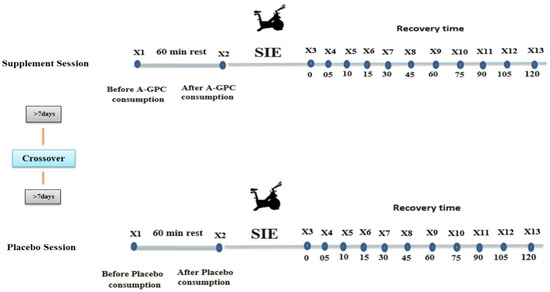
Figure 1.
Research design (X = Measurement).
2.3. Heart Rate Variability
The participants arrived at the laboratory in the morning (07:30 to 08:00 a.m.). A heart rate monitor captured the RR recording (My patch-sl, 3-channles Holter, Los Angeles, CA, USA) in a seated position for 20 min before consuming A-GPC/placebo, 60 min after A-GPC/placebo consumption, and 120 min after the SIE bout. The first 5 min were ignored to establish signal stabilization and were not included in analyses. All the HRV measurements were conducted based on the standards proposed by the Task Force of the European Society of Cardiology [25]. A minimum protection zone of six beats was used to filtrate and correct all artifact and ectopic data. All recorded data with more than 5% error were excluded from the final analyses. Both the time and frequency HRV domains were analyzed using a computer software program (The Biomedical Signal and Medical Imaging Analysis Group, Department of Applied Physics, University of Kuopio, Kuopio, Finland) [26]. The time domain of HRV included the Standard Deviation of RR intervals (SDNN) and the percentage of interval differences of adjacent RR intervals greater than 50 ms (pNN50), which represent vagal modulation. The frequency domain parameters included the low-frequency (LF: 0.04–0.15 Hz) and high-frequency bands (HF: 0.15–0.40 Hz), which were calculated by using fast Fourier transformation (FFT; welch, 256 points Hanning-windowing, Kubios HRV Analysis, Biosignal Analysis, and Medical Imaging Group, University of Eastern Finland, Kuopio Finland) for analysis of the power spectrum. The ratio of the LF-to-HF (LF/HF) bands was also evaluated as an indicator of sympathovagal balance.
2.4. Blood Pressure Measurements
Systolic blood pressure (SBP), diastolic blood pressure (DBP), mean arterial pressure (MAP), and the rate pressure product (RPP) were evaluated before A-GPC/placebo consumption, 60 min after A-GPC/placebo consumption, and for 120 min after the Wingate test using an electronic sphygmomanometer (BPM AM 300P CE, Omron, Omron Company, Kyoto, Japan) based on guidelines of the European Society of Hypertension after A-GPC/placebo consumption [27]. Moreover, HR and SBP were used to calculate RPP (RPP = HR × SBP × 10).
2.5. A-GPC Supplementation
After consuming a standardized breakfast, participants consumed either 1000 mg of A-GPC (RAW powder United Kingdom) or placebo. Both the supplement and placebo were dissolved in 250 mL of water with a similar color and flavor. The A-GPC dose in this study was determined based on the study [15] conducted by Kawamura et al. (2012). According to the pharmacokinetics of the A-GPC supplement, it requires 60 min to reach its peak plasma levels and have maximal impact [28]. The University’s biochemistry laboratory analyzed and verified the supplement independently to determine its safety, presence of the active compound (99% l-alpha glycerylphosphorylcholine), and lack of any contaminant.
2.6. Sprint Interval Exercise (SIE)
In both the supplement and placebo trials the SIE (Wingate) protocol was performed at the same time of the day to control for diurnal variations. The protocol included a 5 min warm-up on an ergometer (Monark 894E Wingate testing bike ergometer, Sweden) at 40 to 60 rpm, which was followed by two 30 s SIE tests with 4 min active recovery (cycling at 40 rpm) between them. To determine the peak power, before starting the SIE test, participants were instructed to cycle as quickly as possible for 5 s, and then participants pedaled as fast as possible for 30 s encouraged verbally by a researcher. The load of 0.55 per kg body weight was placed on the fly-wheel and remained constant for 30 s to determine peak power (WPP) and mean power (WMP) in Watts.
2.7. Statistical Analyses
All data analyses were conducted with the Statistical Package for Social Sciences (SPSS) version 22 (IBM SPSS, Armonk, NY, USA). The Shapiro–Wilk test was used to determine that the data were normally distributed. Repeated measures ANOVA were employed to compare HRV indices (2 protocols × 11 times) and hemodynamics variables (2 protocols × 13 times) between the two trials. If significant differences were found, Bonferroni’s post-hoc comparisons were made. Independent t-tests were conducted to compare anaerobic power during the A-GPC and placebo trials. Effect size (ES) was determined by Partial eta-square, and power (1 − β) was assessed with repeated measures of ANOVA analyses. A p-value of p < 0.05 was considered statistically significant. All data are presented as mean ± SD.
3. Results
There were significant interactions (p < 0.05) between session and time for SDNN (F(2.9,32.4) = 11.2, p = 0.001, ES = 0.50, power = 0.99) (Figure 2A), pNN50% (F(2.5,28) = 9.2, p = 0.001, ES = 0.45, power = 0.98) (Figure 2B), HF (F(2.0,22.8) = 11.7, p = 0.001, ES = 0.51, power = 0.98) (Figure 3B), and LF (F(2.9,32.4) = 28.9, p = 0.001, ES = 0.72, power = 1.0) (Figure 3A). A-GPC consumption increased (p < 0.05) resting levels of SDNN (%14) (Figure 2A), pNN50% (%14) (Figure 2B), LF (%10) (Figure 3A), and HF (%13) (Figure 3B) compared to the placebo (Figure 2 and Figure 3). In both the A-GPC and placebo sessions these HRV variables decreased (p < 0.05) immediately after the SIE protocol, whereas, they increased during recovery to a greater level in the A-GPC than in the placebo session. There was a significant main effect of time for the LF/HF ratio (F(2.8,31.7) = 41.6, p = 0.001, ES = 0.79, power = 1.0) (Figure 3C). Independent of the trials (A-GPC or placebo), LF/HF (p < 0.05) increased immediately after the SIE protocol and decreased during 120 min recovery. However, there were no significant interactions between session and time for the LF/HF ratio (p > 0.05) (Figure 3C).
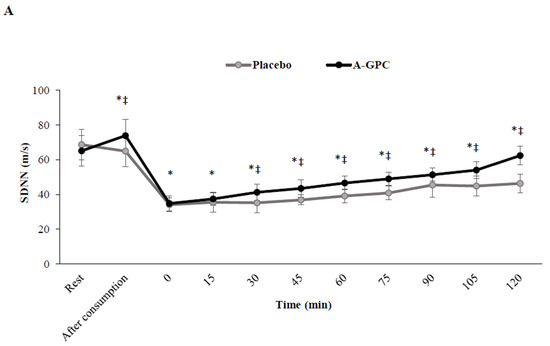
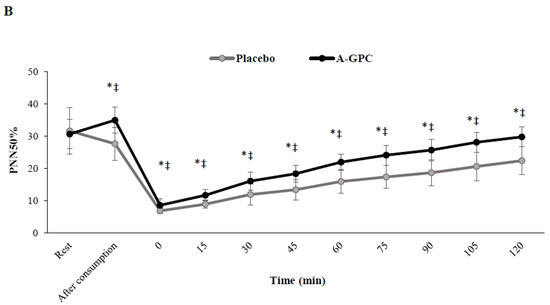
Figure 2.
SDNN (A) and PNN50% (B) at baseline, 60 min after choline or placebo consumption immediately after exercise and every 15 min after exercise. SDNN, Standard Deviation of RR wave intervals; pNN50%, percentage of interval differences of adjacent RR intervals greater than 50 ms. Values are means ± SD. * indicates a significant difference from baseline (p < 0.05); ‡ indicates a significant difference from placebo (p < 0.05).
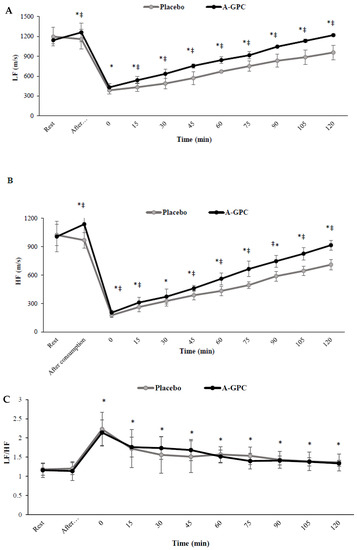
Figure 3.
Low-frequency (A), high-frequency (B) and low-frequency/high-frequency ratio (C) at baseline, 60 min after choline or placebo consumption, immediately after exercise and every 15 min after exercise. LF, low frequency; HF, high frequency. Values are means ± SD. * indicates a significant difference from baseline (p < 0.05); ‡ indicates a significant difference from placebo session (p < 0.05).
There were significant interactions between session and time for SBP (F(3.3,37.2) = 23.5, p = 0.0001, ES = 0.68, power = 1.0) (Figure 4A), HR (F(2.8,31.3) = 33.2, p = 0.0001, ES = 0.75, power = 1.0) (Figure 5A), and RPP (F(2.6,29.4) = 44.4, p = 0.0001, ES = 0.80, power = 1.0) (Figure 5B). Although, SBP, HR and RPP increased (p < 0.05) immediately after the SIE protocol in both trials, SBP increased to a lesser level (p < 0.05) in the A-GPC (%47) than in the placebo (%64) trial (Figure 4 and Figure 5). SBP, HR and RPP decreased (p < 0.05) during recovery in both trials, though they recovered (p < 0.05) faster in the A-GPC compared to the placebo session (Figure 4A). Although, a significant main effect of time was observed for DBP (F(2.9,32.2) = 11.5, p = 0.0001, ES = 0.51, power = 0.99), DBP (p < 0.05) increased immediately after the SIE protocol and decreased during recovery with no significant difference (p > 0.05) between the two trials (Figure 4B).
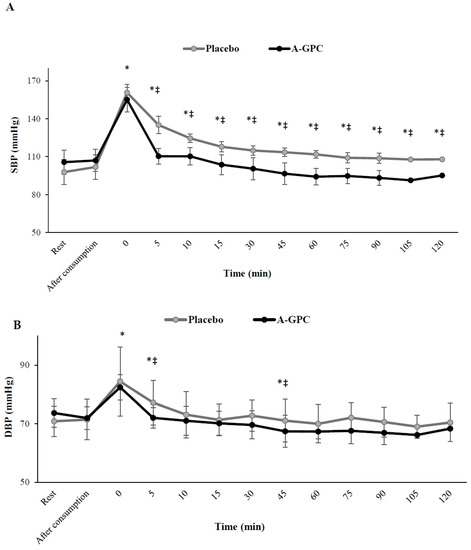
Figure 4.
Systolic (A) and diastolic (B) blood pressure at baseline, 60 min after Choline or placebo consumption immediately after exercise and every 5 min during first 15 min and afterward every 15 min. SBP, Systolic Blood Pressure; DBP, Diastolic Blood Pressure. Values are means ± SD. * indicates a significant difference from baseline (p < 0.05); ‡ indicates a significant difference from placebo session (p < 0.05).
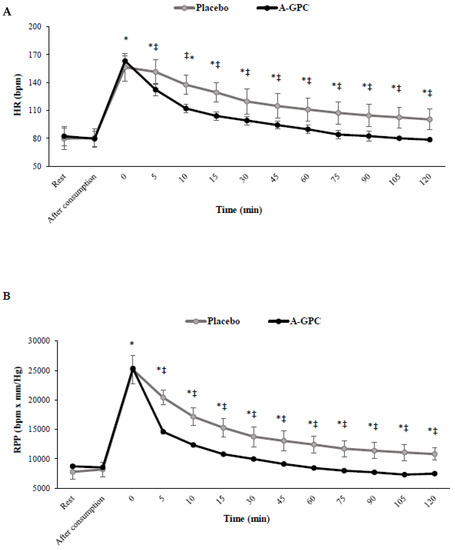
Figure 5.
Heart rate (A) and Rate Pressure Product (B) at baseline, 60 min after choline or placebo consumption immediately after exercise and every 5 min during first 15 min and afterward every 15 min. HR, Heart Rate; RPP, Rate Pressure Product. Values are means ± SD. * indicates a significant difference from baseline (p < 0.05); ‡ indicates a significant difference from placebo session (p < 0.05).
Peak and mean power were (p < 0.05) higher in the A-GPC compared to the placebo session (Table 2).

Table 2.
Mean (±SD) values of power indices (N = 12).
4. Discussion
A-GPC is a food or health supplement that converts to phosphatidylcholine, the active form of choline after ingestion, increasing acetylcholine and free plasma choline [17,18]. However, its influence on cardiac autonomic function, particularly following strenuous exercise, is unclear among adults who are overweight or obese. The main findings of the present study were: (1) A-GPC consumption alone improved both time and frequency domains of HRV variables, (2) these HRV indices decreased and hemodynamic variables increased more pronouncedly immediately after SIE in both A-GPC and placebo trials, which show disruption effects of SIE on cardioautonomic function and hemodynamic variables, and (3) the recovery of HRV (SDNN, pNN50%, HF and LF) and hemodynamic (SBP, HR and RPP) variables were faster in the A-GPC trial, representing the effectiveness of A-GPC in the modulation of both cardioautonomic and hemodynamic variables following SIE in overweight/obese women. Therefore, our initial hypothesis regarding the proper effects of A-GPC on the responses of HRV and hemodynamic indices to SIE was confirmed. Although A-GPC after ingestion might increase acetylcholine and free plasma choline [14,15,17], the precise mechanisms of choline effects on ANS are not clear. Liu et al. (2017) indicated that short-term choline supplementation in hypertensive rats was associated with improvement of vagal activity through its effective role in increasing baroreceptors sensitivity [21]. Moreover, they showed that choline supplementation could have cardioprotective effects by inhibiting toll-like receptor 4, pro-inflammatory cytokines, and upregulation of anti-inflammatory markers [21]. Therefore, although in our study, we did not measure inflammatory markers, the more pronounced favorable changes in HRV and hemodynamic variables following A-GPC consumption, in the present study, might be justified by its role in the inhibition of inflammation and oxidative stress [14,17,29,30]. Another possible mechanism that might be used to justify these findings is the effect of choline on NO stimulation that might modify the cardiac autonomic system (increase HRV) and hemodynamic variables (reduced SBP, DBP and RPP) through reactivation of vagal activity and its vasodilation demeanor [14,20,31]. Since we did not measure NO, oxidative stress and inflammatory markers, more studies are required to shed more light on the mechanisms responsible for ANS and hemodynamic responses to exercise following choline consumption. In general, we found that A-GPC could have a cardioprotective effect following SIE, and these findings would suggest the clinical implication of A-GPC consumption in reducing the risk of cardiac events in overweight/obese women following vigorous exercise.
In our study, the SIE protocol reduced HRV variables while increasing hemodynamic variables, which confirms our original hypothesis and the findings of previous studies [13]. For example, Stuckey et al. (2011) and Ye et al. (2022), demonstrated that SIE protocols (Wingate base) were associated with imposing significant stress on ANS and hemodynamic variables, which might lead to increased risk of cardiac events after these supramaximal exercises [9,13]. Previous studies have shown that vigorous exercise is associated with stimulation of sympathetic activation leading to increased catecholamine production [32,33]. Furthermore, this supramaximal intensity exercise imposes substantial stress, which can cause muscle damage, increase oxidative stress and inflammatory markers and consequently sympathetic overstimulation and delayed parasympathetic reactivation during both exercise and recovery [30,34,35].
Another interesting finding of our study is that acute ingestion of 1000 mL/g of A-GPC improves the peak power, mean power, and fatigue index during the Wingate test. Our results confirm the finding of others who demonstrated increases in mean power, power, and isometric strength during a maximal effort sprint test [36,37]. A-GPC-induced improvements in performance are possibly related to its potential role in increasing choline bioavailability and consequently acetylcholine synthesis augmentation levels in CNS neurons [38]. Moreover, it was shown that A-GPC could improve performance by increasing the growth hormone concentration [15]. However, future studies are warranted to confirm the ergogenic effects of A-GPC on anaerobic performance.
A limitation of the present study was that HRV mostly represents parasympathetic activity and to determine the sympathetic activity, we suggest future studies employ other techniques such as microneurography and systolic time intervals. Moreover, this study focused on the acute consumption of A-GPC, while chronic effects of A-GPC consumption and exercise training might lead to important and solid findings for human health. Therefore, future studies are warranted to shed some more light on the chronic impact of A-GPC on autonomic and hemodynamic variables. Another limitation was the low number of young healthy participants. Thus, our findings may not apply to middle-aged and older adults.
The strength of the current study is that it was performed in a double-blind, randomized cross-over design, which makes the study results more valuable. Additionally, our study shows the clinical implication of A-GPC consumption prior to vigorous exercises by modulation of cardiac autonomic and hemodynamic responses to exercise and recovery, which might be useful for obese individuals for preventing cardiac events and encouraging better recovery. However, more studies are needed to confirm these results and their practical application, particularly by addressing the chronic effects of A-GPC on ANS.
5. Conclusions
We found the A-GPC consumption prior to SIE can attenuate the changes in HRV and hemodynamic variables that typically occur during and after SIE and recovery. Therefore, it may be a useful strategy to reduce the risk associated with supramaximal exercise in individuals who are overweight or obese. Additionally, our study indicates that A-GPC could have ergogenic effects on performance by improving peak power, mean power, and fatigue index. However, more studies are required to determine the mechanisms responsible for A-GPC-induced modulations in ANS and hemodynamics following supramaximal exercise.
Author Contributions
S.P.B., L.S.P., A.F. and S.A. contributed to the conception or design of the work. S.P.B. and S.A. contributed to the acquisition of data. S.P.B., L.S.P. and S.A. contributed to the analysis and interpretation of data. S.P.B. drafted the manuscript. L.S.P., A.F. and S.A. critically revised the manuscript. All authors have read and agreed to the published version of the manuscript.
Funding
This research received no external funding.
Institutional Review Board Statement
All study procedures were conducted according to the latest revision of the Declaration of Helsinki. The study procedures were reviewed and approved by the University’s Research and Ethics Committees (IR.SBU.REC.1400.228) and a clinical trial registry code was obtained (IRCT20160606028290N2).
Informed Consent Statement
All participants completed an informed consent form, which was approved by the University’s Ethics committee.
Data Availability Statement
The datasets generated for this study are available on request to the corresponding author.
Acknowledgments
The authors wish to thank the volunteers for their enthusiastic participation in this study.
Conflicts of Interest
The authors declare no conflict of interest.
References
- Timmis, A.; Townsend, N.; Gale, C.P.; Torbica, A.; Lettino, M.; Petersen, S.E.; Mossialos, E.A.; Maggioni, A.P.; Kazakiewicz, D.; May, H.T.; et al. European Society of Cardiology: Cardiovascular Disease Statistics 2019. Eur. Heart J. 2020, 41, 12–85. [Google Scholar] [CrossRef] [PubMed]
- Rankin, P.; Morton, D.P.; Diehl, H.; Gobble, J.; Morey, P.; Chang, E. Effectiveness of a volunteer-delivered lifestyle modification pro-gram for reducing cardiovascular disease risk factors. Am. J. Cardiol. 2012, 109, 82–86. [Google Scholar] [CrossRef] [PubMed]
- Thayer, J.F.; Åhs, F.; Fredrikson, M.; Sollers, J.J., III; Wager, T.D. A meta-analysis of heart rate variability and neuroimaging studies: Implications for heart rate variability as a marker of stress and health. Neurosci. Biobehav. Rev. 2012, 36, 747–756. [Google Scholar] [CrossRef] [PubMed]
- Yadav, R.L.; Yadav, P.K.; Yadav, L.K.; Agrawal, K.; Sah, S.K.; Islam, N. Association between obesity and heart rate variability indices: An intuition toward cardiac autonomic alteration—A risk of CVD. Diabetes Metab. Syndr. Obes. Targets Ther. 2017, 10, 57–64. [Google Scholar] [CrossRef] [PubMed]
- Powell-Wiley, T.M.; Poirier, P.; Burke, L.E.; Després, J.-P.; Gordon-Larsen, P.; Lavie, C.J.; Lear, S.A.; Ndumele, C.E.; Neeland, I.J.; Sanders, P.; et al. Obesity and Cardiovascular Disease: A Scientific Statement from the American Heart Association. Circulation 2021, 143, e984–e1010. [Google Scholar] [CrossRef] [PubMed]
- Albert, C.M.; Mittleman, M.A.; Chae, C.U.; Lee, I.-M.; Hennekens, C.H.; Manson, J.E. Triggering of Sudden Death from Cardiac Causes by Vigorous Exertion. N. Engl. J. Med. 2000, 343, 1355–1361. [Google Scholar] [CrossRef] [PubMed]
- Ikarugi, H.; Shibata, M.; Shibata, S.; Ishii, H.; Taka, T.; Yamamoto, J. High Intensity Exercise Enhances Platelet Reactivity to Shear Stress and Coagulation during and after Exercise. Pathophysiol. Haemost. Thromb. 2003, 33, 127–133. [Google Scholar] [CrossRef] [PubMed]
- American College of Sports Medicine; Thompson, P.D.; Franklin, B.A.; Balady, G.J.; Blair, S.N.; Corrado, D.; EstesIII, N.A.M.; Fulton, J.E.; Gordon, N.F.; Haskell, W.L.; et al. Exercise and acute cardiovascular events: Placing the risks into perspective: A scientific statement from the American Heart Association Council on Nutrition, Physical Activity, and Metabolism and the Council on Clinical Cardiology. Circulation 2007, 115, 2358–2368. [Google Scholar] [PubMed]
- Stuckey, M.I.; Tordi, N.; Mourot, L.; Gurr, L.J.; Rakobowchuk, M.; Millar, P.J.; Toth, R.; MacDonald, M.J.; Kamath, M.V. Autonomic recovery following sprint interval exercise. Scand. J. Med. Sci. Sports 2011, 22, 756–763. [Google Scholar] [CrossRef] [PubMed]
- Vollaard, N.; Metcalfe, R. Research into the Health Benefits of Sprint Interval Training Should Focus on Protocols with Fewer and Shorter Sprints. Sports Med 2017, 12, 2443–2451. [Google Scholar] [CrossRef] [PubMed]
- Vollaard, N.; Metcalfe, R.; Williams, S. Effect of Number of Sprints in an SIT Session on Change in V’O2max. Med. Sci. Sports Exerc. 2017, 49, 1147–1156. [Google Scholar] [CrossRef] [PubMed]
- Koral, J.; Oranchuk, D.J.; Herrera, R.; Millet, G.Y. Six Sessions of Sprint Interval Training Improves Running Performance in Trained Athletes. J. Strength Cond. Res. 2018, 32, 617–623. [Google Scholar] [CrossRef] [PubMed]
- Ye, Y.; Tong, T.K.; Kong, Z.; Tao, E.D.; Ying, X.; Nie, J. Cardiac autonomic disturbance following sprint-interval exercise in untrained young males: Does exercise volume matter? J. Exerc. Sci. Fit. 2022, 20, 32–39. [Google Scholar] [CrossRef] [PubMed]
- Hartmann, P.; Fet, N.; Garab, D.; Szabó, A.; Kaszaki, J.; Srinivasan, P.K.; Tolba, R.H.; Boros, M. L-alpha-glycerylphosphorylcholine reduces the mi-crocirculatory dysfunction and nicotinamide adenine dinucleotide phosphate-oxidase type 4 induction after partial hepatic ischemia in rats. J. Surg. Res. 2014, 189, 32–40. [Google Scholar] [CrossRef] [PubMed]
- Kawamura, T.; Okubo, T.; Sato, K.; Fujita, S.; Goto, K.; Hamaoka, T.; Iemitsu, M. Glycerophosphocholine enhances growth hormone secretion and fat oxidation in young adults. Nutrition 2012, 28, 1122–1126. [Google Scholar] [CrossRef] [PubMed]
- Marcus, L.; Soileau, J.; Judge, L.W.; Bellar, D. Evaluation of the effects of two doses of alpha glycerylphosphorylcholine on physical and psychomotor performance. J. Int. Soc. Sports Nutr. 2017, 14, 39. [Google Scholar] [CrossRef] [PubMed]
- Tuboly, E.; Gáspár, R.; Ibor, M.O.; Gömöri, K.; Kiss, B.; Strifler, G.; Hartmann, P.; Ferdinandy, P.; Bartekova, M.; Boros, M.; et al. L-Alpha-glycerylphosphorylcholine can be cytoprotective or cytotoxic in neonatal rat cardiac myocytes: A double-edged sword phenomenon. Mol. Cell. Biochem. 2019, 460, 195–203. [Google Scholar] [CrossRef] [PubMed]
- Brownawell, A.M.; Carmines, E.L.; Montesano, F. Safety assessment of AGPC as a food ingredient. Food Chem. Toxicol. 2011, 49, 1303–1315. [Google Scholar] [CrossRef]
- Lopez, C.; Govoni, S.; Battaini, F.; Bergamaschi, S.; Longoni, A.; Giaroni, C.; Trabucchi, M. Effect of a new cognition enhancer, alpha-glycerylphosphorylcholine, on scopolamine-induced amnesia and brain acetylcholine. Pharmacol. Biochem. Behav. 1991, 39, 835–840. [Google Scholar] [CrossRef]
- Sartori, C.; Lepori, M.; Scherrer, U. Interaction between nitric oxide and the cholinergic and sympathetic nervous system in car-diovascular control in humans. Pharm. Ther. 2005, 106, 209–220. [Google Scholar] [CrossRef] [PubMed]
- Liu, L.; Lu, Y.; Bi, X.; Xu, M.; Yu, X.; Xue, R.; He, X.; Zang, W. Choline ameliorates cardiovascular damage by improving vagal activity and in-hibiting the inflammatory response in spontaneously hypertensive rats. Sci. Rep. 2017, 7, 1–13. [Google Scholar]
- Meyer, K.A.; Shea, J.W. Dietary Choline and Betaine and Risk of CVD: A Systematic Review and Meta-Analysis of Prospective Studies. Nutrients 2017, 9, 711. [Google Scholar] [CrossRef] [PubMed]
- Roe, A.J.; Zhang, S.; Bhadelia, R.A.; Johnson, E.J.; Lichtenstein, A.H.; Rogers, G.T.; Rosenberg, I.H.; Smith, C.E.; Zeisel, S.H.; Scott, T.M.; et al. Choline and its metabolites are differently as-sociated with cardiometabolic risk factors, history of cardiovascular disease, and MRI-documented cerebrovascular disease in older adults. Am. J. Clin. Nutr. 2017, 105, 1283–1290. [Google Scholar] [PubMed]
- Thomas, S.; Reading, J.; Shephard, R.J. Revision of the Physical Activity Readiness Questionnaire (PAR-Q). Can. J. Sport Sci. 1992, 17, 338–345. [Google Scholar] [PubMed]
- Malik, M. Heart rate variability: Standards of measurement, physiological interpretation, and clinical use: Task force of the European Society of Cardiology and the North American Society for Pacing and Electrophysiology. Ann. Noninvasive Elec-Trocardiol. 1996, 1, 151–181. [Google Scholar] [CrossRef]
- Tarvainen, M.P.; Niskanen, J.-P.; Lipponen, J.A.; Ranta-Aho, P.O.; Karjalainen, P.A. Kubios HRV–heart rate variability analysis software. Comput. Methods Programs Biomed. 2014, 113, 210–220. [Google Scholar] [CrossRef] [PubMed]
- O’Brien, E.; Asmar, R.; Beilin, L.; Imai, Y.; Mancia, G.; Mengden, T.; Myers, M.; Padfield, P.; Palatini, P.; Parati, G.; et al. Practice guidelines of the European Society of Hypertension for clinic, ambulatory and self blood pressure measurement. J. Hypertens. 2005, 23, 697–701. [Google Scholar] [CrossRef]
- Abbiati, G.; Fossati, T.; Lachmann, G.; Bergamaschi, M.; Castiglioni, C. Absorption, tissue distribution and excretion of radiolabelled compounds in rats after administration of [14C]-l-α-glycerylphosphorylcholine. Eur. J. Drug Metab. Pharmacokinet. 1993, 18, 173–180. [Google Scholar] [CrossRef]
- Strifler, G.; Tuboly, E.; Görbe, A.; Boros, M.; Pécz, D.; Hartmann, P. Targeting mitochondrial dysfunction with L-alpha glycer-ylphosphorylcholine. PLoS ONE 2016, 11, e0166682. [Google Scholar] [CrossRef]
- Zimmer, A.; Teixeira, R.; Bonetto, J.; Bahr, A.; Türck, P.; de Castro, A.L.; Campos-Carraro, C.; Visioli, F.; Fernandes-Piedras, T.R.; Casali, K.R.; et al. Role of inflammation, oxidative stress, and autonomic nervous system activation during the development of right and left cardiac remodeling in experimental pulmonary arterial hyper-tension. Mol. Cell. Biochem. 2020, 464, 93–109. [Google Scholar] [CrossRef]
- Koopman, F.A.; Vosters, J.L.; Roescher, N.; Broekstra, N.; Tak, P.P.; Vervoordeldonk, M.J. Cholinergic anti-inflammatory pathway in the non-obese diabetic mouse model. Oral Dis. 2015, 21, 858–865. [Google Scholar] [CrossRef] [PubMed]
- Jacob, C.; Zouhal, H.; Prioux, J.; Gratas-Delamarche, A.; Bentue-Ferrer, D.; Delamarche, P. Effect of the intensity of training on cat-echolamine responses to supramaximal exercise in endurance-trained men. Eur. J. Appl. Physiol. 2004, 91, 35–40. [Google Scholar] [CrossRef] [PubMed]
- Zouhal, H.; Jacob, C.; Rannou, F.; Gratas-Delamarche, A. Effect of training status on the sympathoadrenal activity during a su-pramaximal exercise in human. J. Sports Med. Phys. Fit. 2001, 41, 330. [Google Scholar]
- Aoi, W.; Naito, Y.; Takanami, Y.; Kawai, Y.; Sakuma, K.; Ichikawa, H.; Yoshida, N.; Yoshikawa, T. Oxidative stress and delayed-onset muscle damage after exercise. Free Radic. Biol. Med. 2004, 37, 480–487. [Google Scholar] [CrossRef]
- Pyne, D. Exercise-induced muscle damage and inflammation: A review. Aust. J. Sci. Med. Sport 1994, 26, 49–58. [Google Scholar]
- Bellar, D.; LeBlanc, N.R.; Campbell, B. The effect of 6 days of alpha glycerylphosphorylcholine on isometric strength. J. Int. Soc. Sports Nutr. 2015, 12, 42. [Google Scholar] [CrossRef]
- Jagim, A.R.; Jones, M.T.; Wright, G.A.; St Antoine, C.; Kovacs, A.; Oliver, J.M. The acute effects of multi-ingredient pre-workout in-gestion on strength performance, lower body power, and anaerobic capacity. J. Int. Soc. Sports Nutr. 2016, 13, 1–10. [Google Scholar] [CrossRef]
- Traini, E.; Bramanti, V.; Amenta, F. Choline alphoscerate (alpha-glyceryl-phosphoryl-choline) an old choline-containing phos-pholipid with a still interesting profile as cognition enhancing agent. Curr. Alzheimer Res. 2013, 10, 1070–1079. [Google Scholar] [CrossRef]
Publisher’s Note: MDPI stays neutral with regard to jurisdictional claims in published maps and institutional affiliations. |
© 2022 by the authors. Licensee MDPI, Basel, Switzerland. This article is an open access article distributed under the terms and conditions of the Creative Commons Attribution (CC BY) license (https://creativecommons.org/licenses/by/4.0/).